Etude de bruit de fond induit par les muons dans l'expérience ...
Etude de bruit de fond induit par les muons dans l'expérience ...
Etude de bruit de fond induit par les muons dans l'expérience ...
Create successful ePaper yourself
Turn your PDF publications into a flip-book with our unique Google optimized e-Paper software.
tel-00724955, version 1 - 23 Aug 2012<br />
3.1 Bolometers 61<br />
(F)ID stands for (Fiducial) Interdigitised <strong>de</strong>tector, with a numbering <strong>les</strong>s than 100<br />
for a mass of 320 g, greater than 200 for a mass of 200 g, and greater than 400 for<br />
a mass of 400 g, cf. Section 3.1.4.<br />
In EDELWEISS-II, there are too many bolometers to be handled by only one<br />
computer. Thus, bolometers are combined in group of up to 10 per acquisition computer.<br />
Each computer has its proper and in<strong>de</strong>pen<strong>de</strong>nt DAQ. When one channel of a<br />
<strong>de</strong>tector of a DAQ computer triggers, the data of the bolometers on this computer<br />
are registered in<strong>de</strong>pen<strong>de</strong>ntly from what happens in the DAQ of other computers.<br />
There are as many runs as DAQ computers.<br />
But note that a run is not a Run. In the data acquisition language, a measuring<br />
period over a few weeks/months is called a Run. A Run is ma<strong>de</strong> up from typically<br />
day-long runs intersected by regeneration periods of ∼ 1 h. In between two physics<br />
Runs are generally a Research and Development (R&D) Run to install and test<br />
more bolometers and improve the setup. Therefore the numbering of Runs is odd<br />
for R&D Runs and even for physics data Runs.<br />
The configuration of bolometers during the physics Run 8, 10 and 12 are shown<br />
in Figure 3.5, 3.6 and 3.7, respectively. There are exclusively standard bolometers<br />
during Run 8, except for one ID, which was implemented for test purpose. Run 8<br />
reproduced EDELWEISS-I on a larger scale. The number of bolometers is growing<br />
in between Run 8 and Run 10, with the installation of NbSi and ID bolometers.<br />
However, there are <strong>les</strong>s bolometers during Run 12, as the system switched to almost<br />
exclusively high performing ID bolometers. During Run 12, as they are well known,<br />
the standard bolometers are in as reference bolometer to witness the system behavior<br />
and test the new electronics.<br />
3.1.7 Data acquisition<br />
For each <strong>de</strong>tector, the data acquisition (DAQ) has to generate from 3 up to 7 channels<br />
per bolometer: heat, ionization from the center electro<strong>de</strong> and ionization from<br />
the guard electro<strong>de</strong> in the case of a standard Germanium bolometer; ionization from<br />
the collecting electro<strong>de</strong> of a si<strong>de</strong>, ionization from the veto electro<strong>de</strong> of the same si<strong>de</strong>,<br />
these two but for the other si<strong>de</strong>, and the same again which correspond to the guard<br />
and finally heat in the case of an interdigitised bolometer. The DAQ of EDELWEISS<br />
is <strong>de</strong>scribed in <strong>de</strong>tail in [149, 160].<br />
Basically when one channel of one <strong>de</strong>tector triggers, all the other channels of all<br />
<strong>de</strong>tectors are registered and read out as one event. The ionization signal is saved<br />
in a time window of 10 ms, the heat signal over 1 s. Besi<strong>de</strong>s the physics signal, the<br />
baseline before the event is also registered, which is called the pre-trigger. The main<br />
action is to choose between an ionization or a heat trigger.<br />
The risetime of the ionization signals is ∼ 1000 times faster than the one for<br />
the heat signals. The advantage is that the time of an event can be known very<br />
accurately, and the search for the heat signal is then facilitated. However, the data<br />
consi<strong>de</strong>red in this work have a heat trigger because of the following reasons:<br />
• The baseline resolutions of the heat channel are typically twice as good as<br />
those of the ionization channel.<br />
• The ionization signal of a nuclear recoil event in Germanium is 3 times lower<br />
than the one of an electronic recoil with the same energy <strong>de</strong>posit, while the<br />
heat signals have the same amplitu<strong>de</strong>. Therefore the trigger is more efficient<br />
3




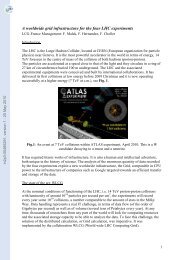

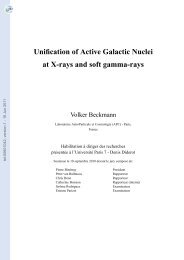

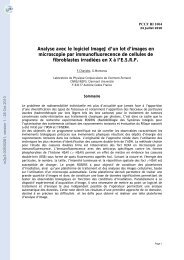
![[in2p3-00383985, v1] NUCLEAR PHYSICS at GANIL ... - HAL - IN2P3](https://img.yumpu.com/19016755/1/185x260/in2p3-00383985-v1-nuclear-physics-at-ganil-hal-in2p3.jpg?quality=85)
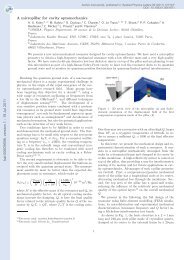
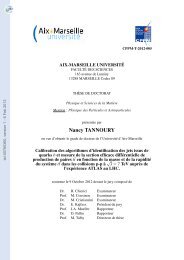
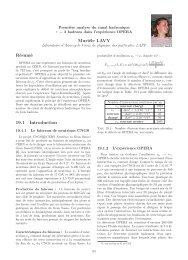
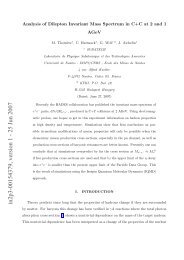
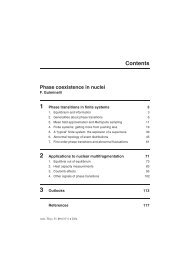
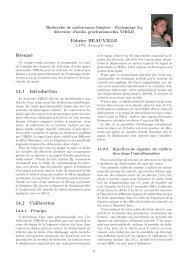
![[tel-00752304, v1] Pions réels et virtuels dans les noyaux](https://img.yumpu.com/19016523/1/184x260/tel-00752304-v1-pions-reels-et-virtuels-dans-les-noyaux.jpg?quality=85)